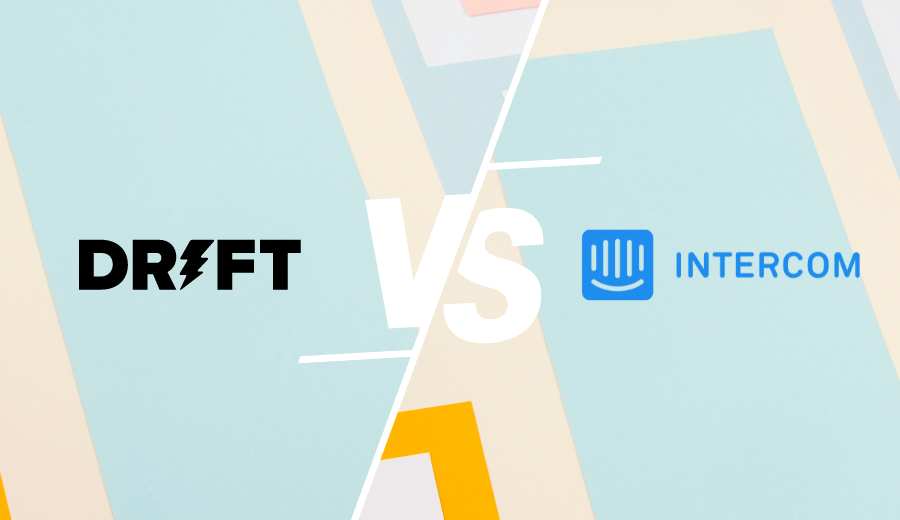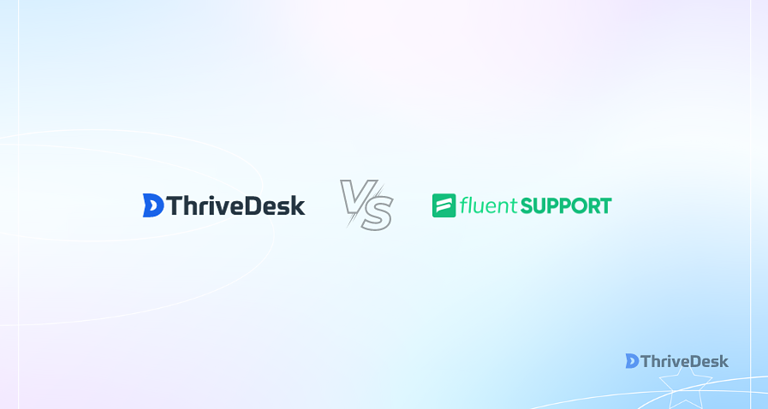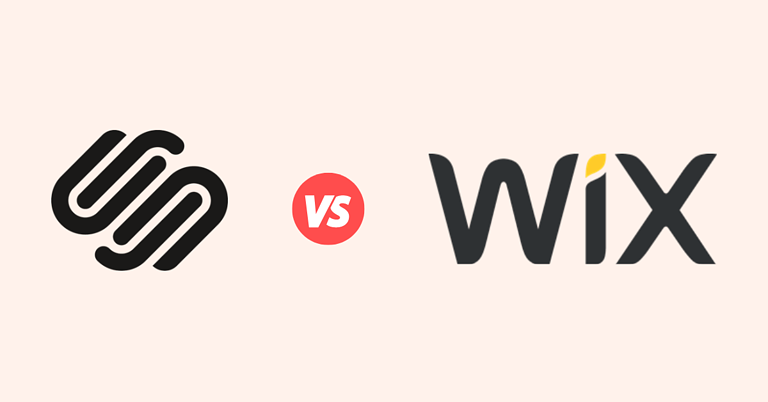Drift and Intercom are top contenders in the world of conversational marketing and customer support. Each offers unique features powered by AI to enhance business communication with customers.
Drift is a leader in conversational marketing. It uses AI chatbots to engage prospects in real-time, capture leads, and qualify them for sales teams. This helps streamline the buyer’s journey and gives sales reps valuable insights to close more deals.
Intercom, on the other hand, focuses on customer support. It goes beyond traditional ticketing with tools for in-app chat and automated responses. Intercom provides a seamless experience across multiple channels, making it more than just a helpdesk—it’s a full-fledged CRM.
In this comparison of Drift vs Intercom, we will look at the strengths of both platforms. We will explore their AI capabilities and help you decide which one can best improve your customer support and engagement. Join us for a closer look at how Drift vs. Intercom can elevate your business.
QUICK NOTE: If you are a startup or SMB, Drift or Intercom might not be a good fit for you. Check out ThriveDesk, our take on customer support software for startups or SMBs.
Drift vs Intercom at a glance
| Criteria | Drift | Intercom |
|---|---|---|
| Rating | 4.4/5 | 4.5/5 |
| Niche | Small, mid-sized and enterprise businesses | Small, mid-sized and enterprise businesses |
| Starting price | $2500/month | $39 per seat/mo |
| Free trial | 14 days | 14 days |
Overview of Drift

Drift is a leader in conversational marketing and sales, transforming how businesses connect with prospects and customers. With advanced technology and an easy-to-use interface, Drift offers tools to drive engagement, nurture leads, and boost revenue.
Drift’s conversational intelligence enables real-time messaging, helping businesses capture leads and start personalized conversations. Use chatbots, live chat, and other channels for a seamless experience. The automation streamlines lead qualification and nurturing. Create intelligent playbooks and workflows for personalized interactions.
Empower sales teams with Drift’s lead management and integration features. Sync customer data across platforms for valuable insights. Gain insights with Drift’s analytics and reporting tools. Track metrics, measure performance, and optimize your strategies.
Drift integrates with popular third-party tools, streamlining workflows and centralizing customer data for better collaboration.
Use Drift for engaging conversations, intelligent automation, lead nurturing, sales enablement, analytics, and integrations – the ultimate solution for marketing and sales success.
Overview of Intercom
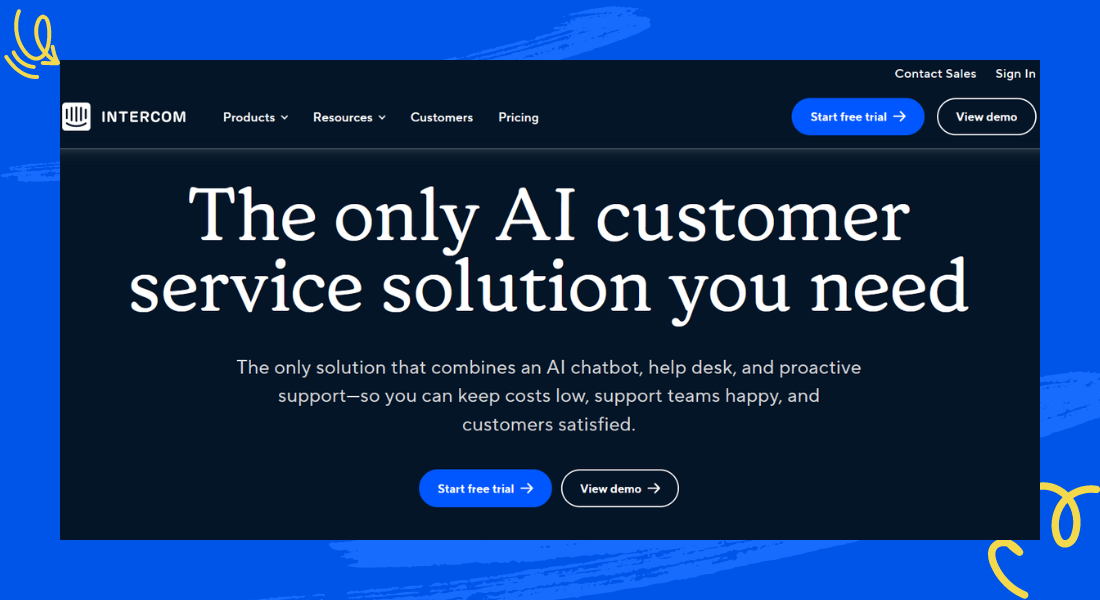
Intercom is the go-to solution for businesses seeking to elevate customer support and sales processes. With its user-friendly interface and advanced functionalities, Intercom offers a comprehensive suite of tools designed to effectively communicate and engage with customers.
Intercom’s messaging system enables real-time interactions through various channels, including chat, email, and in-app messages. Connect with customers wherever they are for timely assistance and personalized experiences.
Experience targeted communication with Intercom’s automation and segmentation features. Create personalized messages for specific customer segments, driving engagement and satisfaction. Streamline support processes with Intercom’s ticketing system and knowledge base. Efficiently manage customer inquiries and empower customers to find answers independently.
Seamlessly integrate Intercom with popular third-party tools and platforms, centralizing customer data and improving workflow efficiency. Gain valuable insights with Intercom’s analytics and reporting capabilities. Track key metrics, measure campaign success, and optimize customer engagement strategies.
Experience the comprehensive power of Intercom for effective customer communication, automation, support tools, integrations, and analytics.
Comparative Analysis: Key Features and Functionality
When comparing Drift and Intercom, evaluating their core features and functionalities is essential to determine which platform best suits your organization’s customer support needs. Let’s explore how Drift and Intercom stack up in terms of basic functionalities required by helpdesk software.
| Features | Drift | Intercom |
|---|---|---|
| Integrations | Drift offers integration with a wide range of popular tools and platforms, including CRMs, marketing automation systems, and analytics tools, enabling seamless data synchronization and streamlined workflows | Limited integrations are available. Their app market currently holds around 100 apps |
| Self-service portal | Drift allows businesses to create a self-service knowledge base, enabling customers to find answers to common questions independently | Intercom offers a self-service portal where customers can find answers to their questions, with a knowledge base, community forum, and articles |
| Live chat | Drift’s live chat functionality enables real-time conversations with prospects and customers, facilitating lead capture and personalized engagement | Intercom offers live chat for customer support agents to communicate with customers in real-time |
| Reporting | Drift provides robust reporting and analytics capabilities, allowing businesses to track key metrics, measure campaign performance, and gain valuable insights into conversational marketing and sales efforts | Intercom offers limited reporting and analytics |
| Mobile app | Drift offers a mobile app for both iOS and Android, enabling sales and support teams to stay connected and engage with prospects and customers on-the-go | Intercom offers a mobile app for both iOS and Android |
| AI | Drift leverages AI-powered chatbots and conversational intelligence to automate lead qualification, nurturing, and engagement processes, providing a personalized and efficient experience for prospects and customers | Intercom will soon release its GPT 4-powered customer service bot called Fin. Fin will understand complex queries, ask clarifying questions, and fully converse with customers |
| Customer support | Drift offers 24/7 email and chat support | Intercom offers 24/7 customer support support via email and chat |
| Ticket Management | While Drift’s primary focus is on conversational marketing and sales, it integrates with popular customer support platforms to enable effective ticket management and resolution processes | Intercom offers a robust ticketing system that centralizes customer inquiries, allowing support teams to manage and resolve tickets effectively. It provides features such as ticket assignment, escalation, and SLA management to streamline the ticket resolution process. |
| Automation | Drift excels in automation with its conversational intelligence capabilities. Businesses can create automated playbooks and workflows tailored to specific buyer personas, automating lead qualification, nurturing, and engagement processes | Intercom provides automated workflows that guide agents through predefined steps, ensuring consistent and standardized support processes. They also have bots which can automate tasks such as answering customer questions, qualifying leads, and booking demos. |
Our pick: Intercom
Some additional Comparison metrics
Unique features
As you dive deeper into the world of customer support and engagement, you’ll discover that Drift and Intercom offer some distinctive features that set them apart. Let’s explore these unique offerings and see how they can benefit your business.
Drift
Drift takes a unique approach by specializing in conversational marketing and sales acceleration. Its AI-powered chatbots facilitate real-time conversations, capturing and qualifying leads for sales teams. Drift enables businesses to create intelligent playbooks and automated workflows tailored to buyer personas, ensuring personalized lead nurturing and engagement. With a strong focus on sales enablement, Drift provides context-rich insights that empower reps to prioritize promising opportunities and close more deals effectively.
Intercom
Now, let’s shift our focus to Intercom’s unique offerings. Intercom has a different approach, one that’s all about sales, marketing, and personalized messaging. Intercom has your back if you’re looking to supercharge your sales efforts. It’s like having a toolkit for lead generation, customer segmentation, and crafting highly personalized messages. This makes it an excellent choice if you want to engage with support and potential and existing customers in real time. Intercom has also dipped its toes into the AI market with their GPT-4 powered chatbot called Fin.
Our pick: Tie. Both have unique features which lend well to excellent customer service.
Drift vs Intercom vs ThriveDesk: Pricing and plans
When evaluating helpdesk solutions such as Drift and Intercom, it is essential to grasp the pricing models and plans to ensure an informed choice. Let’s examine the pricing structures of both platforms, assess their cost-effectiveness and scalability, and scrutinize any potential extra expenses or undisclosed fees associated with each platform. We’ve also thrown in ThriveDesks pricing for a more well-rounded comparison.
| Pricing | Drift | Intercom | ThriveDesk |
|---|---|---|---|
| Pricing Model | Customizable plans | Fixed plan | Per user per month |
| Number of Pricing Tiers | 3 (Premium, Advanced, Enterprise) | 3 (Starter, Pro, Premium) | 3 (Starter, Plus, Enterprise) |
| Trial Period | 14 days | 14 days | 7 days |
| Free Plan Available | No | No | No |
| Lowest Priced Paid Plan | $2500/month (Only available pricing listed on their website) | $39 per seat/month | $25/month |
| Highest Priced Published Plan | Customizable plans | $139/month | $49/month |
| Custom Enterprise Pricing | Yes | Yes | No |
| Annual Billing Discount | No | Yes | Yes |
| Add-on/Integration Pricing | Additional cost | Additional cost | No added cost |
| Ease of Cost Evaluation | Difficult | Difficult | Easy |
If money is limited for your business, a help desk that can be a Drift alternative or an Intercom alternative is ThriveDesk. We offer straight forward pricing plans designed to meet the diverse needs of businesses, with only 3 options to choose from; it makes it easier for business owners to make a decision regarding pricing. Choose the plan that suits your support requirements and budget, whether you’re a small team or a growing enterprise.
Our pick: ThriveDesk. Less confusing and straightforward.
Value for money and scalability
Drift
Drift provides exceptional value for money by offering a range of pricing plans tailored to meet the needs of businesses of all sizes. Its conversational marketing and sales acceleration features deliver a strong return on investment by streamlining lead generation, nurturing, and engagement processes. Drift’s scalable architecture allows businesses to easily expand their conversational marketing and sales efforts as their requirements grow, ensuring a seamless and cost-effective growth strategy.
Intercom
Intercom also offers scalability within its pricing plans, enabling businesses to upgrade to higher tiers as their support needs grow. With its integrated suite of applications, Intercom provides a comprehensive solution that caters to businesses seeking a unified ecosystem to manage customer interactions. This scalability ensures businesses can align their support infrastructure with their evolving requirements, ensuring a seamless customer experience.
Our pick: Intercom.
Additional Costs and Hidden Charges
When selecting a helpdesk or project management platform, it’s crucial to consider the base pricing and any potential additional costs and hidden charges that may impact your budget. Let’s delve into how Drift and Intercom handle these aspects.
Drift
Drift is generally transparent about its pricing structure, offering a range of plans to accommodate businesses of different sizes and needs. However, it’s essential to be aware of potential additional costs and hidden charges:
- Professional Services: While Drift provides robust self-service resources, businesses may require professional services for implementation, integration, or custom development, which can result in additional fees.
- Premium Integrations: Certain premium integrations with third-party tools or platforms may incur additional costs or require separate licensing.
- Usage-Based Fees: Drift may charge usage-based fees for features like conversational marketing, chatbot interactions, or messaging volumes that exceed the limits of your chosen plan.
- Enterprise Features: Advanced features like custom branding, granular access controls, or dedicated support may be available only at higher pricing tiers or as add-ons, resulting in increased costs.
Intercom
Intercom is a relatively transparent company when it comes to pricing and additional costs. However, there are a few things to be aware of before signing up for a plan:
- Overage Fees: Exceeding your plan limits may result in overage fees, with costs varying based on your plan and usage.
- Customizations: While Intercom offers useful customization options like branding and custom fields, these can be costly and may need extra support.
- Add-on Modules: Intercom provides add-on modules like the Inbox (email support) and Product Tours (interactive guides) which enhance functionality but can also add expenses and require support.
- API Usage Fees: Heavy reliance on the Intercom API may lead to additional charges beyond a certain limit.
Our pick: Tie. Both offer considerable customizations in a variety of different ways.
User experience and interface
A helpdesk solution’s user experience and interface are crucial in ensuring efficient and intuitive customer support. Let’s evaluate the user experience and interface of both Drift and Intercom, considering factors such as ease of navigation, customization options, and overall intuitiveness. We will also consider customer feedback and reviews to provide insights into the usability of each platform.
Drift
- Drift’s interface is designed to be intuitive and user-friendly, with a focus on streamlining the conversational marketing and sales processes.
- The platform offers customization options to personalize the user experience, such as branding elements, chat window styles, and workflow configurations.
- Drift’s interface provides a unified view of customer interactions, enabling sales and support teams to easily access conversation histories, lead details, and relevant data
- Customer feedback often highlights Drift’s clean and modern interface, praising its ease of use and seamless integration of conversational intelligence features.
- The platform’s intuitive design and well-organized layout contribute to an efficient and enjoyable user experience for both customers and internal teams.
Intercom
- Intercom focuses on providing an interface that facilitates easy navigation and accessibility. Users can seamlessly move between sections and locate the required features and functionalities.
- Intercom offers extensive customization options, empowering businesses to adapt the interface to their requirements. Users can customize ticket forms, workflows, and layouts, ensuring a tailored support experience.
- Intercom’s interface is designed to be intuitive, allowing support agents to interact with customers seamlessly. The platform’s layout and organization of information contribute to an efficient and user-friendly experience.
- Users often praise Intercom for its simplicity and straightforward navigation. The intuitive design of the platform, coupled with its comprehensive features, results in positive user feedback regarding the overall user experience.
Our pick: Intercom. UI/UX can be subjective to some degree, but to us, Intercom has better UI and is overall more intuitive to use.
Customer Feedback and Reviews
In terms of G2 ratings, Drift and Intercom are both well-rated platforms. Drift has a rating of 4.4 out of 5 stars based on over 1158 reviews. Intercom has a rating of 4.5 out of 5 stars, based on over 2700 reviews.
Drift
The general consensus between their customers focuses on a few common patterns.
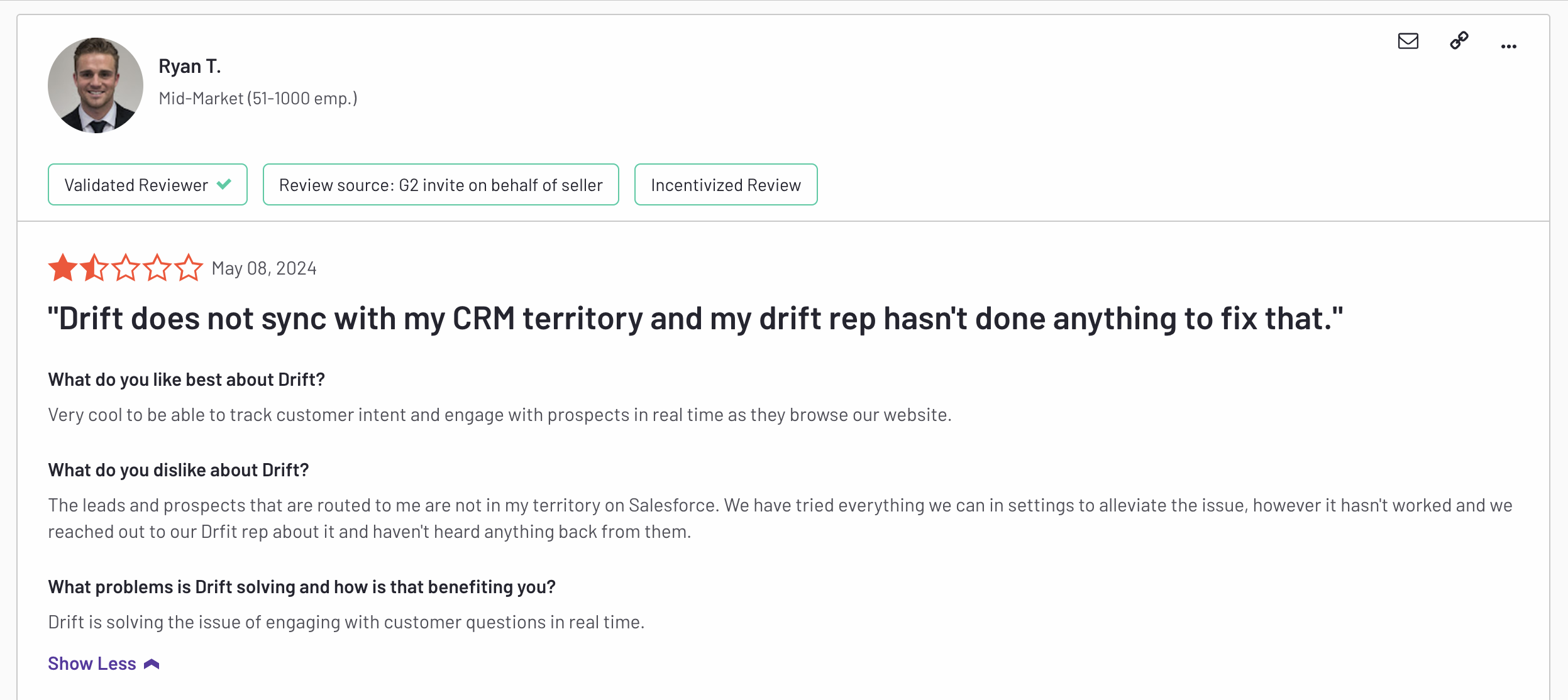
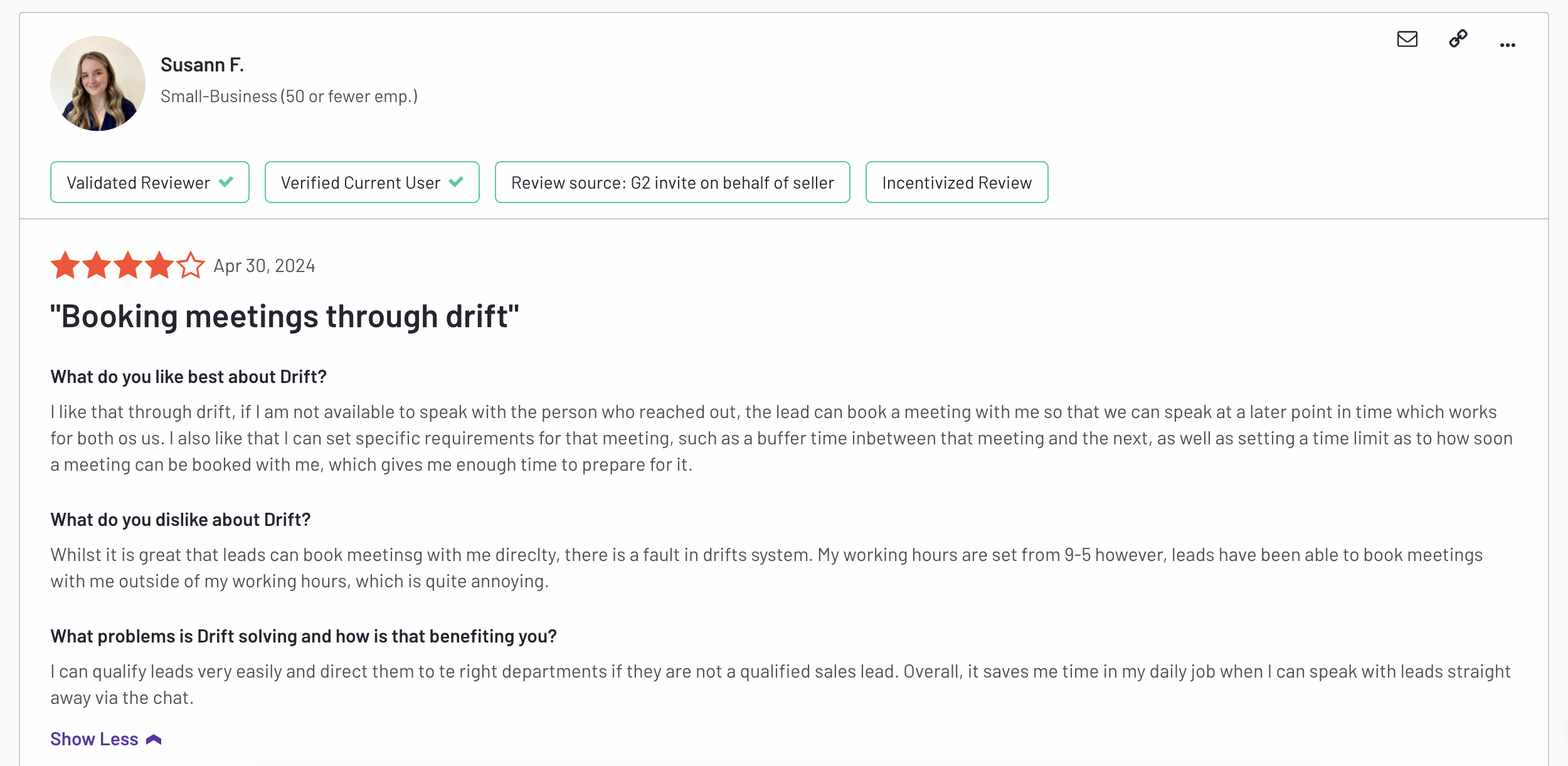
Drift receives positive feedback from customers for its intuitive and user-friendly interface, which streamlines conversational marketing and sales processes. Many users appreciate the platform’s ability to capture and qualify leads effectively, as well as its seamless integration with other tools and platforms.
Customers also highlight Drift’s exceptional customer support and comprehensive training resources, which contribute to a smooth implementation and adoption process.
Intercom
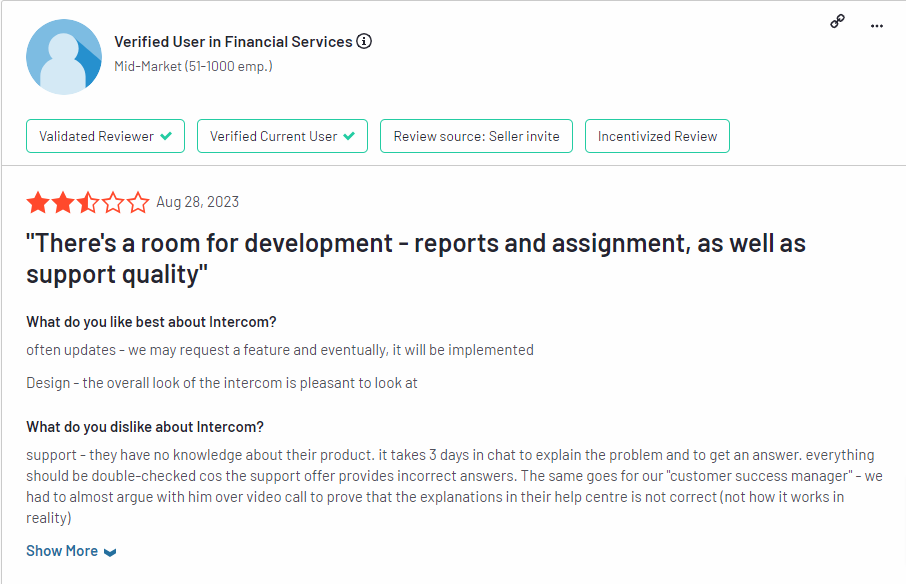

Intercom is praised as an affordable option with high customization capabilities, allowing businesses to create a personalized support experience. Although the interface may require a learning curve, users find the platform effective and functional.
However, some users have expressed concerns about the platform’s limited customization options and the potential for high costs, particularly for smaller businesses or those with more advanced requirements.
Our pick: Intercom. Acknowledging that this is a subjective category, we looked at 100 reviews for each and considering the limited sample size, Intercom had more reviews over 4 stars compared to Drift.
Drift vs Intercom: Pros and Cons Face-Off
Both Drift and Intercom offer varying flavors to curate the customer support experience. Let’s see how their strengths and weaknesses stack up.
Drift
| Pros | Cons |
|---|---|
| Easy to use | Doesn’t offer a robust self-service portal like Intercom’s knowledge base and community forum |
| Designed to encourage natural conversation-like interactions with website visitors | Can be expensive compared to some competitors, especially for basic features on lower tiers |
| Connects with popular marketing and sales tools like Salesforce and Marketo (higher tiers). | Limited ticketing functionalities compared to dedicated support platforms like Intercom |
| Helps identify and qualify potential leads through chat interactions | Automation features primarily geared towards marketing and sales tasks, not general customer support workflows (may require additional tools) |
| Offers 24/7 support via email and chat | No free plan |
Intercom
| Pros | Cons |
|---|---|
| Focuses on sales and marketing, with features such as lead generation, customer segmentation, and personalized messaging | Not as well-suited for complex customer support requirements |
| Easy to use and configure | |
| Scalable to meet the needs of growing businesses | |
| Large and active community of users and developers | |
| Excellent customer support |
Which is right for you?
Drift is an excellent choice if your primary focus is on conversational marketing and sales acceleration. Its AI-powered chatbots, automated playbooks, and conversational intelligence capabilities make it an ideal solution for businesses looking to streamline lead generation, nurturing, and engagement processes. With a strong emphasis on sales enablement, Drift empowers sales teams to close more deals effectively by providing context-rich insights and prioritizing promising opportunities.
Intercom is a suitable option if you’re seeking a comprehensive solution that combines customer support, engagement, and marketing efforts into a cohesive experience. Its robust self-service features, omnichannel communication capabilities, and automation features make it well-suited for businesses that prioritize personalized customer interactions and lead nurturing across multiple channels. Additionally, Intercom’s scalability and extensive customization options cater to the evolving needs of growing businesses.
Here is a table that summarizes the key differences among Drift vs Intercom vs ThriveDesk:
| Feature | Drift | Intercom | ThriveDesk |
|---|---|---|---|
| Price | Starts at $2500, billed annually | Starts at $39 per seat/month | Starts at $25/month |
| Features | Conversational marketing, lead capture, chatbots, live chat, sales enablement tools, automation, and reporting | Unified inbox, live chat, targeted messages, team collaboration tools, automation and reporting | Ticket management, live chat, knowledge base, shared inbox, Self-service portal and reporting, |
| Ease of use | Intuitive and user-friendly interface | Easy to use and configure | Easy to use and configure |
| Scalability | Scalable architecture for growing conversational marketing and sales needs | Good growth speed to value to ratio but limited scalability | Better utilized for small to mid-sized businesses |
| Community | Active community of users and integrators | Large and active community of users and developers | Active community of developers and contributors |
| Customer support | 24/7 customer support available | 24/7 support via email and chat | 24/7 support via email |
ThriveDesk: Customer Support Solution for Startups and SMBs

In addition to Intercom vs Drift, alternative helpdesk solutions are available in the market. One such alternative worth considering is ThriveDesk. ThriveDesk is a feature-rich helpdesk solution that offers a comprehensive set of tools to manage customer support effectively.
ThriveDesk is a help desk software tailor-made for businesses seeking extensive features and a powerful yet simple live chat assistant. Even better, it’s the most cost-effective, lightweight, and speedy live chat solution available for Shopify business owners.
ThriveDesk empowers small businesses to manage real-time customer communications. Packed with convenient built-in features like shared inbox, instant replies, file sharing directly from the chat widget, emojis for effective communication, satisfaction surveys, sales tracking reports for eCommerce, knowledge base search, and monitoring capabilities, you can efficiently handle your Wix store operations.
Rest assured, ThriveDesk’s lightweight design and speed won’t impact the performance of your Wix-powered eCommerce website. The optimized agent interface ensures rapid responses for maximum efficiency, all while keeping your website running smoothly.
Rated 5 stars out of 5 on G2, ThriveDesk is highly regarded by users.
Key Features of ThriveDesk:
- Self Service Portal (WPPortal)
- Third-party Integrations
- Performance Metrics
- Live Chat
- Workflow Management
- Alerts / Escalation
- Ticket Management
- Customer Database
- Email Management
- Extensive Knowledge Base
- Surveys & Feedback
- Pricing for ThriveDesk starts at just $25 per month.
Pros of ThriveDesk:
- Cost-effective, reducing agent costs
- Minimizes customer effort
- Easy installation and usage
- Smooth onboarding experience
- Seamless navigation between chat interactions
- Real-time responses
- ThriveDesk’s user-friendly interface comprehensive resources (including a community, shared mailbox, and live chat), have made it a popular and trusted choice for Wix users. It comes highly recommended for its reliability and ease of use.
Cons of ThriveDesk:
- Lack of native mobile alerts
With ThriveDesk, you can supercharge your website’s growth and streamline customer interactions.
Conclusion: Drift vs Intercom for Your Business
In our analysis of Drift vs Intercom, both platforms stand out for enhancing customer support and engagement. Drift is great for conversational marketing and sales acceleration, using AI chatbots for real-time interactions and lead nurturing.
Intercom, on the other hand, offers a complete suite for customer communication, support, and lead nurturing across multiple channels. It serves as a robust CRM with extensive features.
Choosing between Drift vs. Intercom depends on your business needs. If real-time, personalized interactions are your focus, Drift is ideal. For a unified support and marketing system, Intercom is a strong choice.
Both platforms leverage AI, automation, and analytics to boost customer experiences and streamline operations. Evaluate your goals, budget, and growth plans to select the platform that best meets your needs. This alignment will help you maximize the benefits of either Drift or Intercom, enhancing your customer support and engagement strategies.

